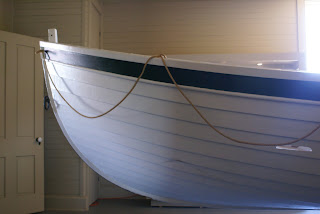
These men were some of the bravest, most foolhardy people the U.S. Government had in its employ. Their job was to find wrecked ships along their section of beach, five miles or so in either direction, and rescue the crews and passengers, no matter what the conditions. They called themselves surfmen and their motto was “You have to go out; you don’t have to come back.” They lived in Spartan conditions, the wood-burning stove in the mess room the only source of heat—in freezing weather, they heated bricks on the stove and wrapped them in flannel to take to their bunks. The open cupola along the roof ridge was manned 24 hours a day, rain or shine, hurricane or blizzard. Like today’s firemen, their job was to put themselves in harm’s way for the safety of others. Failure was always an option, nearly every station lost surfmen to waves or the cold. Not going out was never considered. The rule book stated that a surfman “will not desist from his efforts until by actual trial, the impossibility of effecting a rescue is demonstrated. The statement of the captain that he did not try to use the boat because the sea or surf was too heavy will not be accepted unless attempts to launch were actually made and failed.”

The surfboat, an open wood-planked 20-foot affair, weighing 3000 pounds, rested on a carriage with extra large wheels in the ground level boat room. The eight man crew of surfmen dragged the boat to the beach to launch through storm waves often over 20 feet high. These boats were always rowed by the men. Motors were almost never used. As one surfman said, “Motors can quit; men never will.”

If the storm surf was of suicidal fury and attempts at launching were unsuccessful, the surfboat also carried a Lyle gun, a small cannon used to launch a grappling hook-like projectile to the crippled vessel. A thin rope called the shotline was attached to the projectile. Regulations called for the gunner to fire the projectile into the rigging of the stranded ship. Using the shotline, the surfmen hauled larger lines and pulleys to the ship to create a continuous loop with a breeches buoy, a one-man harness, attached. Passenger and crew rode the buoy from the ship to beach one by one.

Six stations ranged along the Delaware shore with another four in Maryland. Surfmen patrolled on foot in two-man shifts, each man walking the beach for five miles north or south of the station. They carried patrol clocks to ensure they patrolled their stretch of beach. They also carried Coston flares to warn ships too close to the beach or to burn at a wreck to alert the station lookout and to let the ship’s crew know they had been located and that help was on the way.
Although Cape Hatteras lays claim to the title “graveyard of the Atlantic”, the mid-Atlantic Delmarva Peninsula has had more shipwrecks. The Indian River Station saw seven major wrecks in its history. Some stations like the one at Bethany Beach, saw none, and others such as the one at Lewes at the entrance to Delaware Bay made nearly fifty rescues. Stations were expected to assist each other when possible and Alexander Graham Bell set up one of the first telephone systems in America so stations to communicate with each other up and down the coast.
Reading the accounts of rescues leaves me in awe of these people. The surfmen at Lewes once went for 72 hours without sleep or hot food during a screaming north-easter in 1889. With the help of the Cape Henlopen and Rehobeth Beach crews, they went from one wreck to another, rowing out with frozen hands and protesting muscles to rescue nearly 100 people from ships which wrecked one after the other over the course of the three-day storm.

In 1891, the Indian River crew attempted a near epic rescue of the schooner Redwing, wrecked down beach across the Inlet. The surfmen dragged their boat two miles to the flooded inlet, and could not cross on the flood tide. They reloaded the heavy boat back on its carriage and dragged it to nearby Rehobeth Bay, packed the carriage into the boat, and relaunched to cross the bay. It took nearly five hours to reach the wreck, and by then, the Redwing was a total loss with all hands. The surfmen spent the next day on the beach finding the bodies of the crew and paid out of their own pockets for graves at the nearby Ocean View Presbyterian Church. You can still see the site today with an added mystery—the schooner’s manifest listed six crewmen and the surfmen collected six bodies from the beach. There are seven graves in the Redwing plot.
No comments:
Post a Comment